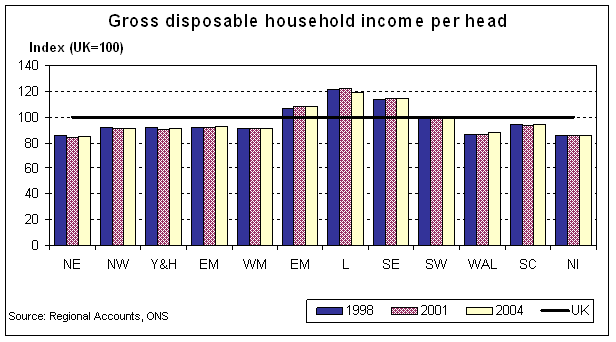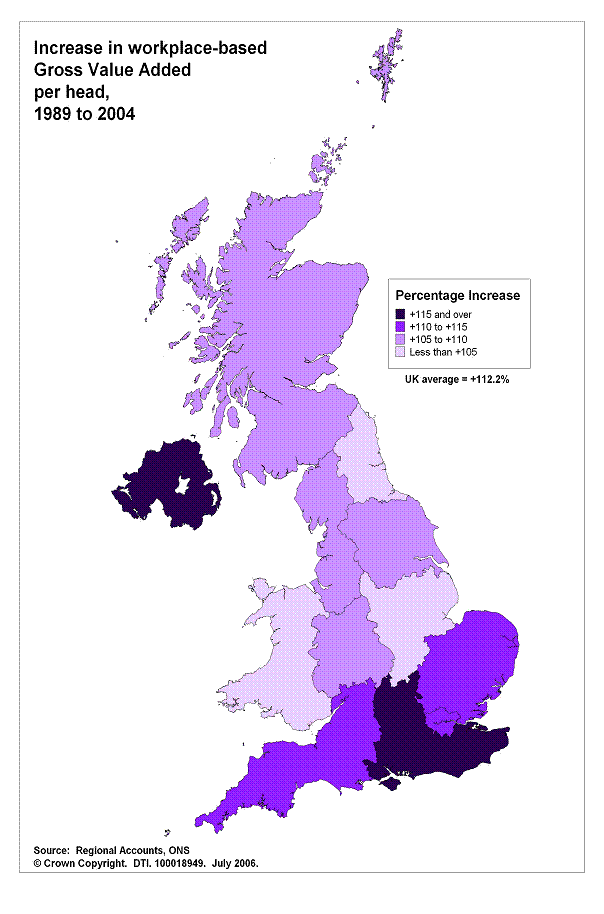Section 1 Overall Competitiveness
1. Gross Value Added (workplace basis) and gross disposable household income per head
Gross Value Added (GVA) and Gross Disposable Household Income (GDHI) measure different aspects of a region�s income. GVA gives an indication of the value of the economic activity generated within an area, while GDHI provides an indication of the income received by resident households and non-profit organisations that serve households.
Workplace-based GVA allocates the incomes of commuters to where they work, rather than where they live. Workplace and residence estimates differ only in the East of England, London and the South East.
The regional GVA estimates included in this publication are those published by the Office for National Statistics (ONS) on 21st December 2005.
GVA (workplace basis) per head
GVA measures the economic activity generated within a region through the production of new goods and services. Table 1(a)(i) and 1(a)(ii) detail GVA at current prices in � per head indexed to the UK average, and � per head.
Between 1989 and 2004, London consistently had the highest GVA per head of population, growing from �11,877 in 1989 to �24,955 in 2004 (varying between 146 and 152 per cent of the UK average during these years). Map 1(a) shows that the South East and Northern Ireland had the greatest percentage increase during this time, at about 130 per cent and 128 per cent respectively. By contrast, East Midlands, North East and Wales were the slowest growing, increasing by 102 per cent, 102 per cent and 98 per cent respectively between 1989 and 2004. Over the same period, the all items Retail Price Index (RPI) increased by 62 per cent.
Chart 1(a)
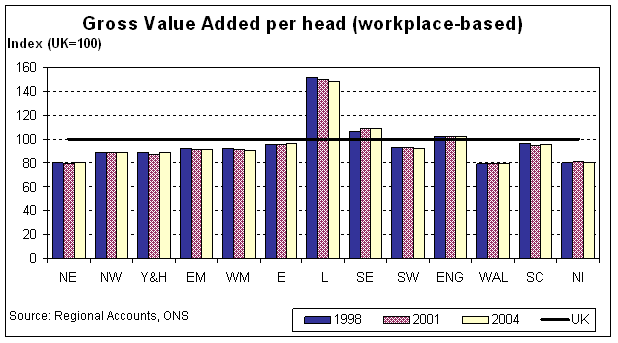
Gross disposable household income per head
Disposable household income is defined as total household income (including benefits) less current taxes on income, wealth and other social contributions. While GVA gives an indication of the value of all economic activity in a given area, gross disposable household income (GDHI), (Tables 1(b)(i) and 1(b)(ii)), measures what financial resources households have available to spend on goods and services.
During 2004, GDHI per head of population in London, at �15,298, was 19 percentage points above UK income per head (�12,816). The North East and Northern Ireland had the lowest relative income at �10,906 and �10,988 per head respectively, 15 and 14 percentage points below the UK average. In 2004, regional GDHI was above the UK average in three regions: East of England (�13,889), London (�15,298) and South East (�14,656).
All the UK regions have experienced growth in GDHI. Between 1995 and 2004, the index of income per head for Northern Ireland fell by almost 3 points, the largest fall in any UK region or country during this time, whereas the index for the South East rose 3.6 points. The South East also had the highest growth at just over 54 per cent in the same period.
2. Labour productivity
This is an indicator of competitiveness within the manufacturing, services and other sectors (including agriculture, forestry and fishing, fuel extraction, electricity and gas supply and construction). Table 2(a) is calculated as GVA per workforce job.
Growth in GVA per workforce job in manufacturing between 1996 and 2003 was highest in Northern Ireland at 37 per cent, followed by the South West, at 30 per cent. In most regions growth in the manufacturing sector was above the all item Retail Price Index (RPI) inflation (18.7 per cent over this period), except for the East of England (17 per cent) and Wales (9 per cent).
In the services sector, the fastest growing region was the West Midlands at over 46 per cent growth between 1996 and 2003. Northern Ireland experienced the slowest growth at just over 33 per cent, followed by Wales and the North East, both at just over 37 per cent. The remaining (�other�) sectors show more variation between regions: London increased by almost 47 per cent between 1996 and 2003, while Northern Ireland experienced growth of just 8.5 per cent.
It is important to consider the value of these indicators in the context of the mix of industries between regions. Some industries are highly labour intensive and so may have relatively low productivity figures when compared with the more capital-intensive industries. Chart 2(a) illustrates the value of GVA per workforce job for manufacturing and services in the UK regions.
Chart 2(a)
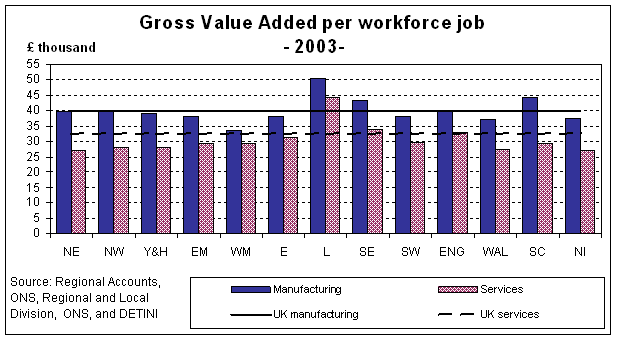
GVA per job filled and per hour worked
The estimates in Tables 2(b)(i) and 2(b)(ii) along with Charts 2(b)(i) and 2(b)(ii) overcome two of the issues affecting GVA per head of population as an indicator. The GVA generated within a region - Table 1(a) - is workplace-based, while the population estimate is based on persons residing within a region. Thus commuting may artificially inflate the GVA per head estimates for regions with a high level of inward commuting, such as London.
GVA in table 2(b)(i) is shown relative to the number of jobs filled in the region and is used as a proxy for GVA per worker. This measure allows fairer comparison of productivity across regions, taking into account total numbers of filled jobs within an area. In 2004 London (at almost 125 per cent) had the highest GVA per job filled when compared to the average (UK=100). The difference between the other regions was less marked than GVA per head of population (table 1(a)) with all indices being within roughly 10 per cent of the average, except for Northern Ireland being 14 per cent lower than the UK average.
In Table 2(b)(ii), GVA is presented relative to the number of hours worked in the region. Similar patterns to table 2(b)(i) emerge with London being the highest, at 119 per cent of the UK average in 2004, and the differences between regions are not as marked as for GVA per head of population. The lowest figure for relative GVA per hour during 2004 was for Northern Ireland, at 82 per cent of the UK average. Of the English regions, the lowest figures were recorded in the Yorkshire and Humber at 91.4 per cent, followed by the North West as the next lowest at 92.5 per cent.
Chart 2(b)(i)
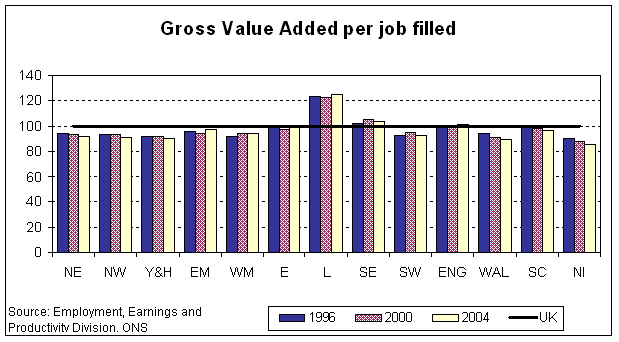
Chart 2(b)(ii)
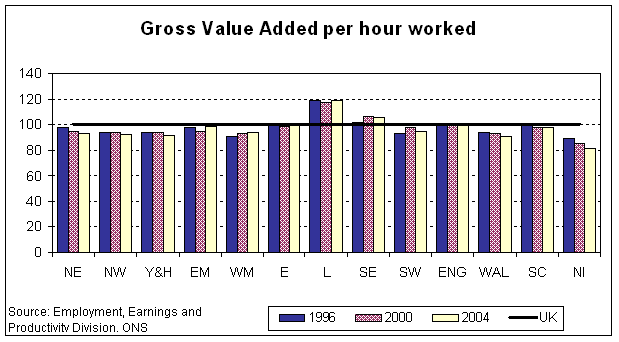
3. Investment and output by UK and foreign-owned companies by broad industry
sector
This series is included as an indicator of the importance of both domestic and
foreign investment to the industrial base of each region.
Tables 3(a) and
3(b) show the trends in the figures for the investment and output of foreign- and
UK-owned companies between 1998 and 2003.
Net Capital Expenditure of firms is used as a proxy for investment. The estimates for individual years should be treated with caution as large, one-off investment decisions by companies can make significant differences to total investment figures in a particular region or year. To help overcome this, manufacturing investment from foreign-owned companies in Chart 3 is shown as an average for the years 1998 to 2003.
Over this period, an average of �16.2 billion per year was invested in manufacturing in the UK, and just over 30 per cent of this was from foreign-owned companies. During the same time, an average of �55.3 billion per year was invested in services in the UK of which 12 per cent was from foreign-owned companies.
GVA is used as a proxy for output. These GVA data are taken from the Annual Business Inquiry and do not correspond to those in the Regional GVA Release published by Regional Accounts, ONS. See Definitions for further details.
In 2003, just over 30 per cent of UK output (as measured by GVA) in the manufacturing sector was from foreign-owned companies. Output from foreign-owned companies, as a proportion of total output, was highest in Wales and the North East at 44 and 41 per cent respectively.
Chart 3

4. Exports of goods
The value of exports produced is dependent on the size of a region�s economy. It
is important to note that the production of some goods (for example motor
vehicles) can involve several separate stages of production that may take place
across more than one region, so these figures should be interpreted carefully.
Table 4(a)(i) provides the value of exports of goods from each region in each quarter between 2001 and 2005 and table 4(a)(ii) presents these as a proportion of headline regional GVA. Table 4(b)(i) provides an estimate of the total number of companies in each region exporting outside the UK from 2001 to 2004. Table 4(b)(ii) shows the number of companies in each region exporting goods to the European Union (EU25) and outside the EU25. As traders may export to both EU and non-EU countries, the sum of the two does not correspond to the totals in table 4(b)(i). As well as this, the counts of companies exporting to the EU and the Rest of the World in Table 4(b)(ii) are not wholly comparable. See Definitions for further details.
Chart 4(a) illustrates the value of exports per employee job from 2001 to 2005 within each region. Map 4(b) shows the same information for 2005 only. In 2005, the value of exports per employee job was highest in the East Midlands and the South East, both at just under �8,900. The South West yielded the lowest value at around �4,750 per employee. Between 2001 and 2005 the value of exports per employee job in the UK increased by 8 per cent. Within the regions, there was a decrease of 28 per cent in Scotland and increase of 23 per cent in Yorkshire and the Humber in the same period. This difference between regions is also reflected in total value of exported goods where Scotland fell 12 per cent and Yorkshire and the Humber rose 48 per cent between the fourth quarters of 2001 and 2005. The value of exports from the UK increased by 23 per cent in this period.
Chart 4(a)(i)
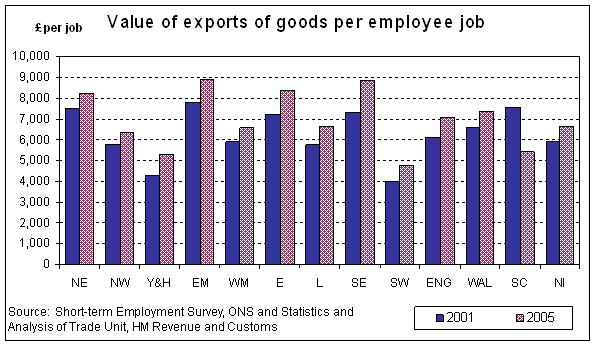
�
Chart 4(a)(ii)
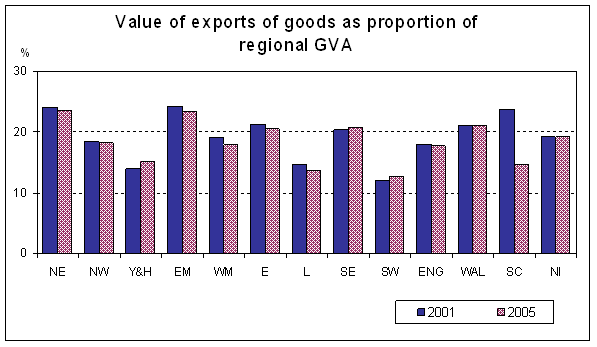
Between the fourth quarters of 2001 and 2005, the number of companies exporting
goods increased in the UK by 14 per cent (from 45,500 to 51,800 exporting
companies). Table 4(b)(i) shows that this pattern was reflected across all
regions in this period, with the largest growth in Northern Ireland with 36 per
cent more exporting companies.
Table 4(b)(ii) shows that Northern Ireland also
had the biggest increase in companies exporting to the EU in the fourth quarter
of 2005 when compared to a year earlier (11 per cent). Numbers of companies
exporting outside the EU increase modestly in all the English regions and
Scotland between the fourth quarters of 2004 and 2005, whereas the numbers
decreased in Wales and Northern Ireland.
Chart 4(b)
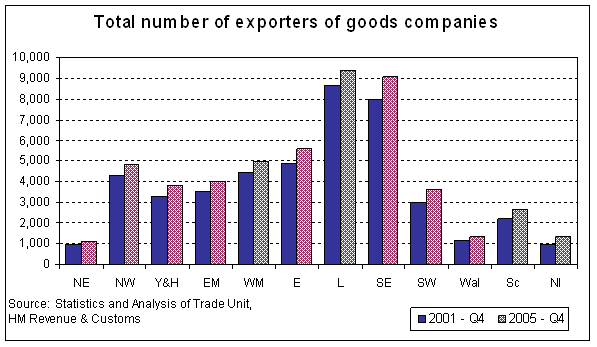
Table 4(c) shows the distribution of regional exports to the main world regions.
During 2005, the EU was the largest recipient of exported goods in all of the UK
regions; with an overall 56.5 per cent (by value) of UK exports were received by
EU countries. This was more than 3 times the value of the goods exported to the
UK�s next largest recipient, North America.
Regional trade in services, taken from the International Trade in Services (ITIS) Inquiry, are shown in Table and Chart 4(d). London and the South East dominate in the value of service exports, respectively representing 46 and 25 per cent of total UK exports in 2003. Figures should be used with caution as the ITIS only covers roughly a third of all UK service exports.
Chart 4(d)
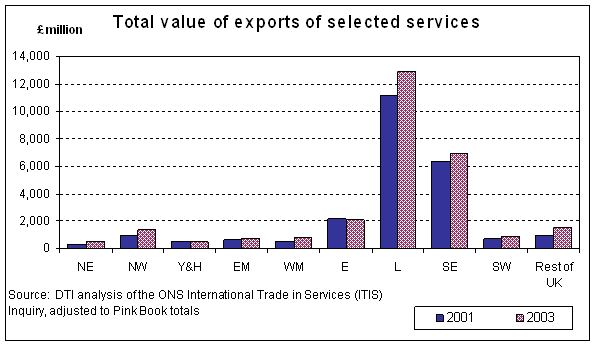
Map 4(b)
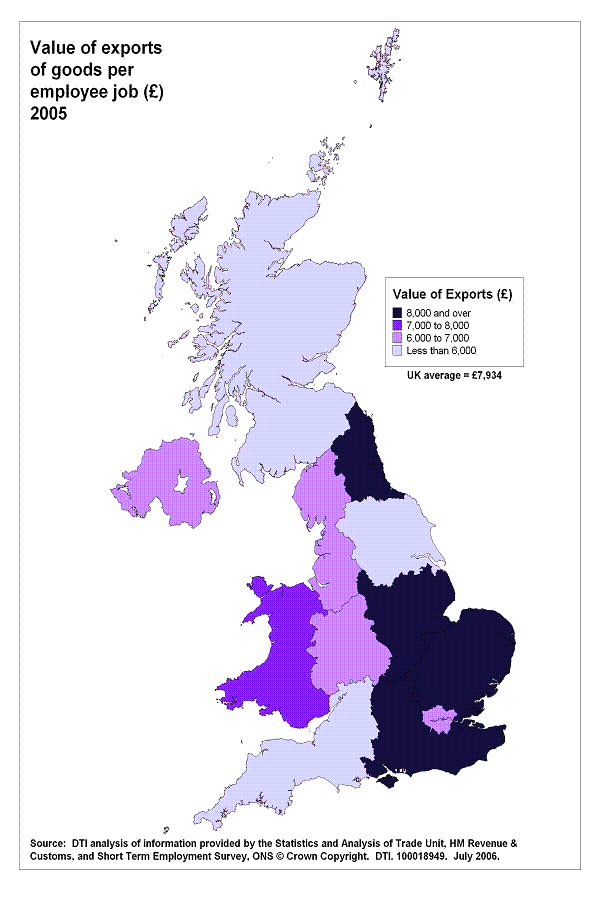
�
